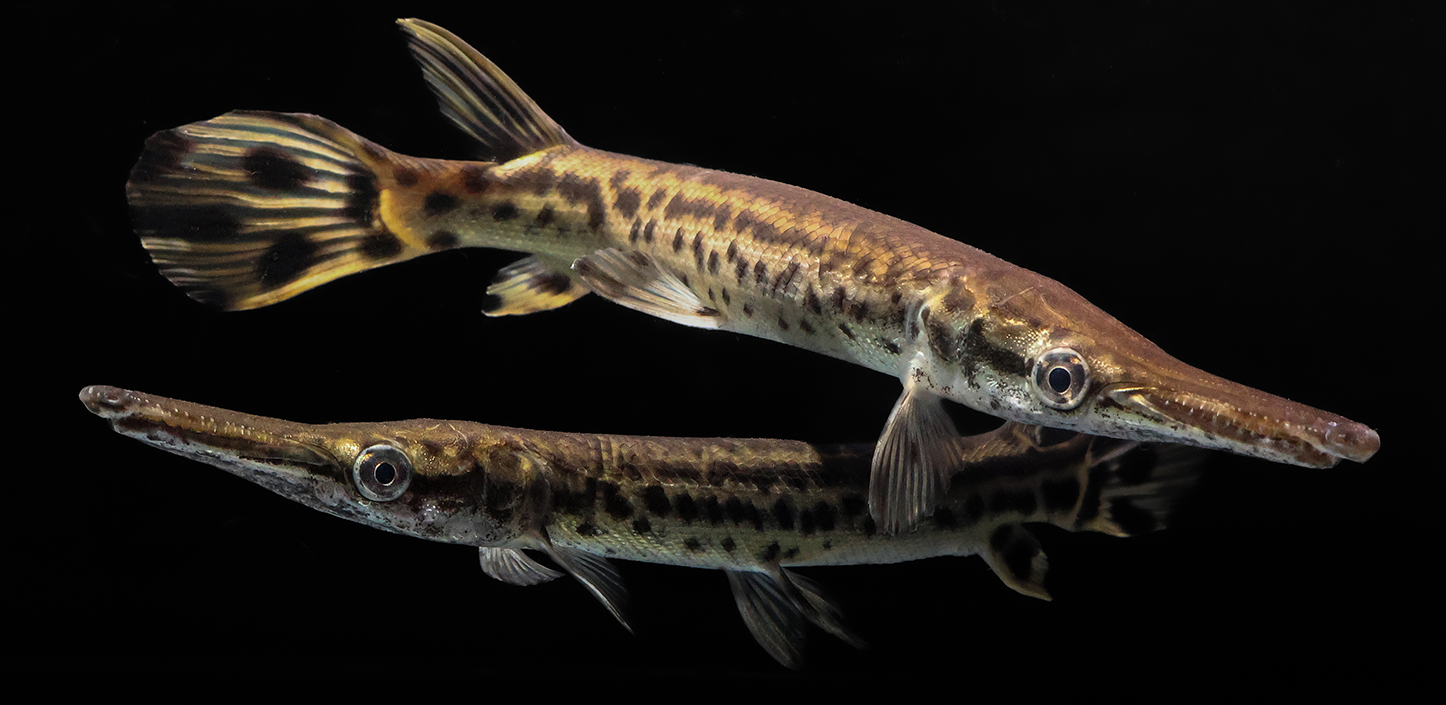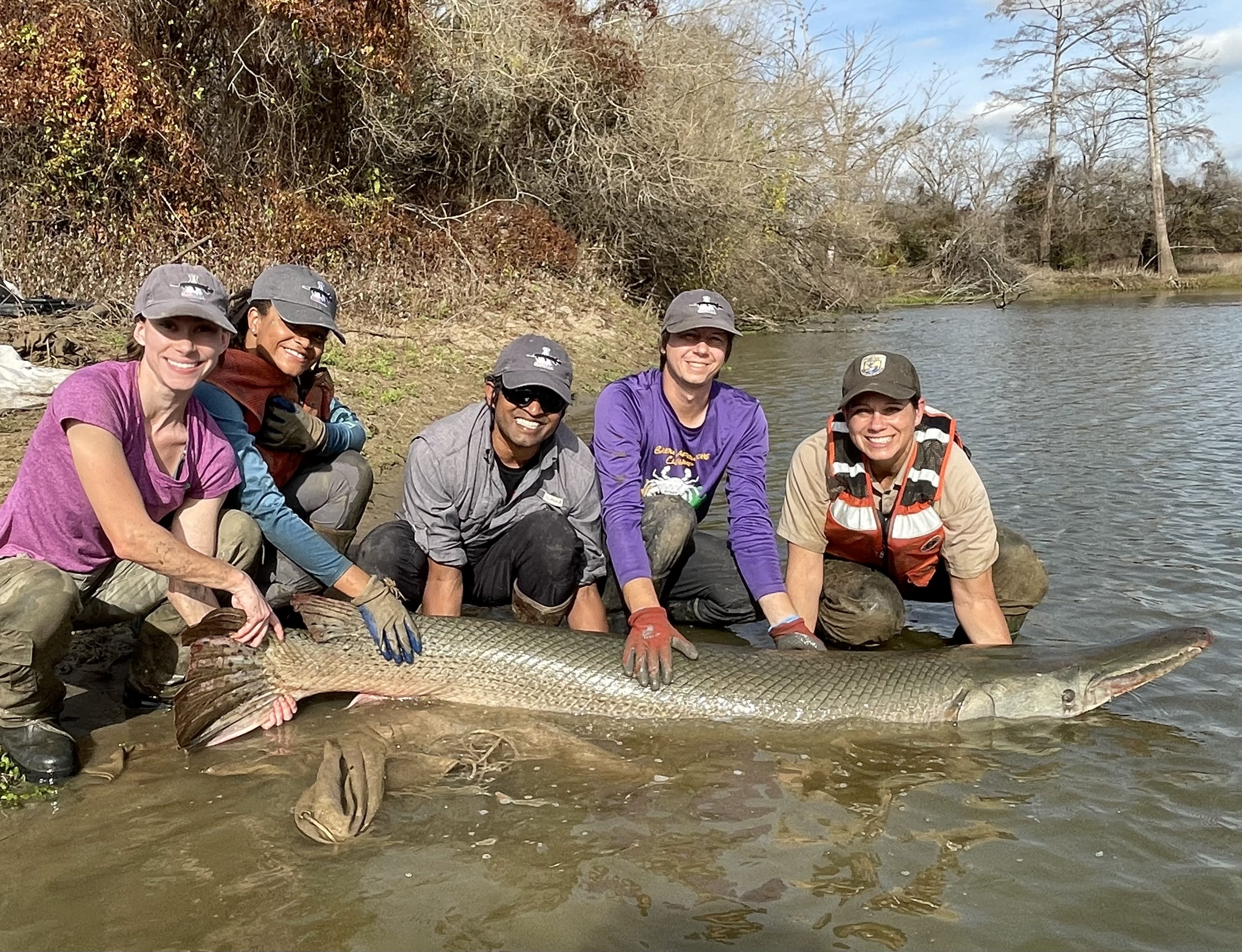
Giving alligator gar a lifeline in the Lower Mississippi River
In newly reconnected backwaters of the Lower Mississippi River, an ancient fish finds its way home.
At dawn, the woods are hushed and damp. River water meanders between towering trees, and a long shadow glides just beneath the surface. A flash of silver breaches the surface before sliding back into the murky water. To most, it’s a familiar scene along the winding path of the Mississippi River in Louisiana. But to the biologist watching, it’s a sign of progress: a fish returning to a place it once couldn’t reach.
That fish is the alligator gar, one of North America’s largest freshwater fish, capable of growing over 8 feet long and living for more than a century. With a lineage stretching back over 150 million years, these ancient fish are living fossils. Adapted to use floodplain environments when water levels are high, alligator gars can breathe air at the surface and migrate back to the main river channel when water levels recede. These river giants are the mascot of this floodplain story and open the door to what’s possible when waterways are reconnected.
Across parts of the Lower Mississippi River, floodplain reconnection projects are allowing water from the river to reach areas that it would have historically, and on a more natural schedule. At Loch Leven, a privately owned oxbow lake on the Mississippi side of the river, about 6,000 acres now fill and drain predictably, preventing fish from becoming stranded in shallow ponds. Across from Loch Leven in Louisiana, at the Richard K. Yancey Wildlife Management Area, repaired culverts and a new weir are restoring movement among lakes, streams and the river. These efforts are part of a broader restoration across the nation’s largest remaining active river floodplain—roughly 2 million acres spanning six states.
These benefits ripple far beyond fish. Across the Lower Mississippi River, the river generates $157 billion in annual revenue and supports more than 585,000 jobs across sectors like agriculture, manufacturing, freshwater supply and tourism, and more. Efforts to reconnect waterways and floodplains make communities more resilient by increasing nature’s capacity to store water and improving water quality, so people see fewer flood impacts, cleaner tap water, and upgraded access for fishing and recreation.
In addition to the community impact, hundreds of species—from birds to mammals—benefit from this river reconnection effort. But few tell the story as clearly as the alligator gar.
“Alligator gars are good indicators of floodplain health,” says Dr. Solomon David, an assistant professor at the University of Minnesota and a lead researcher on alligator gar. “They migrate between rivers and floodplains, so their presence and reproduction can show whether our restoration efforts are effective.”
Alligator gars are like the river’s storytellers. Their behavior reveals how healthy the Mississippi River really is. These ancient fish depend on the river’s natural rhythm of flooding and receding. When the river rises and spills into its floodplains, the gar move into the shallow, quiet waters to lay their eggs. These nursery zones give young gar a safe place to grow, offering food and shelter.
But if floodwaters recede too quickly—or don’t reach the floodplain at all—those eggs won’t survive. That is why finding young gar is a great indicator of healthy reconnection. It means the river is rising high enough and flooding wide enough for these natural life cycles to happen.
Following recent river reconnection projects in the Lower Mississippi floodplain, Dr. David and his team set out to see how well the efforts are working by looking for young gar. They found them.
When the team finds alligator gar, they collect fin tissue, known as “fin clips,” from the gar and return with them to GarLab at the University of Minnesota for stable-isotope analysis. The chemistry in that small sample carries a “signature” of the habitat where the fish fed and grew, so the team can determine whether a fish grew on the floodplain or spent most of its time in the river. It is more than a head count; it is a way to confirm that these places are not only passable but are raising fish.

“We measure our success by checking if adult alligator gars are present and spawning in the restored floodplains,” says Dr. David. “We confirm this through visual counts, and stable isotope analysis of fin tissue, which can tell us where these fish hatch, feed and grow.”
The fieldwork requires dedication and patience. Dr. David’s crew aims to visit sites two to three times a year. Spring allows for monitoring adult gar on the move, and summer for sampling nursery zones for young gars if levels allow. December gives a low-water perspective of floodplain resident gars at multiple life stages. Each trip adds to a growing before-and-after dataset that tracks whether reconnection is boosting reproduction and growth.

But there is a humility to using gar as a yardstick, as these are long-lived animals. You do not rebuild a century-fish’s prospects in a single season. That is why the team keeps returning, and why this story is still being written.
All this work is a product of collaboration. The Lower Mississippi River Conservation Committee (LMRCC), the U.S. Fish and Wildlife Service, the Louisiana Department of Wildlife and Fisheries, International Paper, The Nature Conservancy, University of Minnesota and others are the reason these reconnections are real and not just wishful thinking. Since 2020, NFWF, International Paper, the Walton Family Foundation and the U.S. Fish and Wildlife Service have funded LMRCC projects that help stitch floodplains back to the river.
And the results are visible, even as the story continues to unfold. Young gar in knee-deep nursery water. Birds feeding along the shore. Downstream, tap water runs clearer and beyond the tree line the road stays dry, and the river flows. These are not isolated scenes—they’re part of a pattern that stretches from Loch Leven to Yancey and across the valley. It’s reconnection at work: a quiet fix with visible results for wildlife and for the communities that share this river.